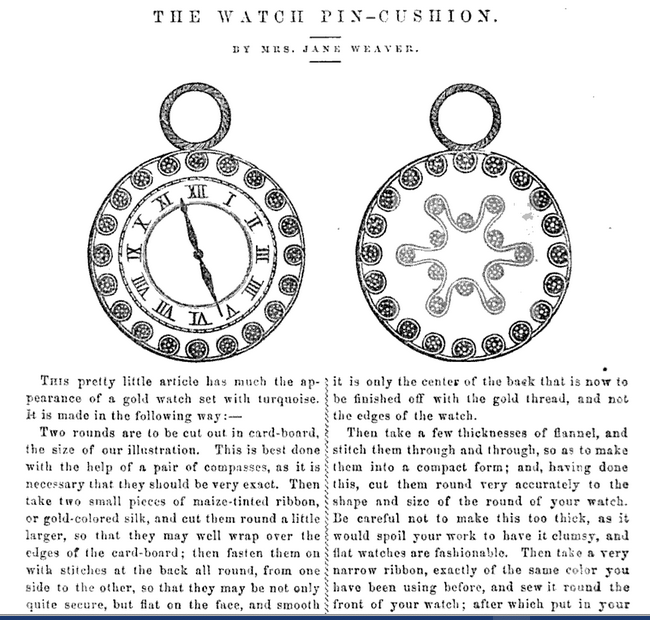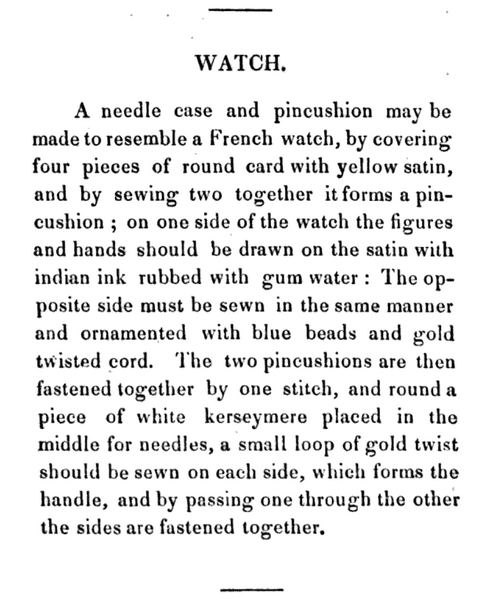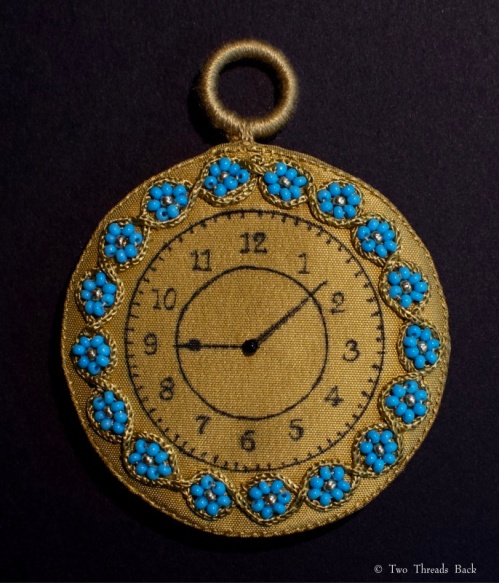Tiny pin cushions have a special charm, particularly the disk shape, with pins inserted around the perimeter. I always considered it an impractical design though, for sewing. Then one day I came across Mrs. Child’s comment in The Girl’s Own Book (1833) and my dim light bulb clicked on:
What are called “bachelor’s pin-cushions” are made very thin so that gentlemen can carry them in their pockets…. Two round pieces of paste-board are covered with silk, and neatly sewed together, with one or two thin pieces of flannel between them. Of course only one circle of pins can be put in.
Well, of course! They were meant to be portable and keep pins securely tucked away, likely for use in one’s toilette, and not necessarily handy for needlework.

Maybe I fixated on this design because it’s extremely pretty, or maybe because it’s unusual to find that many of the same homemade craft surviving. However, according to a knowledgeable source, this particular one is not uncommon. Even a rare mutation – pink beaded! – has been sighted.

Hmm. Were they made by a single crafty lady? Several crafty sisters? A craft class? Who knows. But I did feel like there was probably a pattern that they all followed; the resemblance was quite striking. So I did what any good researcher does these days and hit Googlebooks.

Aha! It looked like Godey’s Lady’s Book could have been the source. But wait. As you know if you read the history of this sewing machine ad (or maybe you knew it anyway), if it was published once, it was quite likely “borrowed” by – or from – someone else, too.

Sure enough, it seems that Mrs. Jane Weaver of Peterson’s Magazine provided the same pattern the year before! Yep, word for word. Did Sarah borrow from Jane? Or did they both copy another pattern?
Even though I’d found American patterns for the pin cushions, it was unlikely that they were the source for the antique ones. Notice the numbers? Roman vs. Arabic numerals. The antique pin cushions I saw had Arabic; the published American patterns used Roman.
Perhaps they thought a little change would deflect any accusation of plagiarism. With almost everything in print copied by somebody, somewhere, who would even notice? The surviving examples were English – I think – so perhaps the original pattern was also.
Back to Googlebooks for an English source. And indeed, I located another pattern published earlier, in England. The Boys’ and Girls’ Companion featured the watch pin cushion, this time credited to Madame Eugenie, in 1857. And that’s where I met a dead end.
Madame Eugenie? I haven’t been able to locate a needlework author by that name, so maybe it was a pseudonym. There were quite a few frantically creative women trying to survive by publishing needlework books and magazines during those years, so she may remain anonymous.


For now anyway, the pattern for the antique “watches” with numbers and star design remains unidentified. Well then, back to creating my own (economy) version. Since I couldn’t find materials exactly like the originals, I had to do some contriving.
- Silk satin > silk taffeta
- India ink and pen > Micron 005 pen
- Tiny gold and turquoise beads > the smallest Hobby Lobby carried
- Card-board > cardboard (yay!)
- Wool flannel > wool flannel (yay again!)
- Compasses for drawing circles > washers from my husband’s toolbox
- Gold cord > embroidery floss + threads pulled from the fabric + upholstery braid unwound
- Silk ribbon > a strip of fabric





As per usual, the whole project turned out to be an excruciating exercise in “making things up as you go along.” What I learned:
- Compromise when it comes to materials.
- Make a pattern first. MAKE A PATTERN FIRST.
- Line the silk.
- Practice writing on paper. Then on fabric. Then give up and use a font on the computer and trace it.
- Press gathers flat.
- Use tinier stitches than seem necessary.
- Beads unpick faster than expected.
- The result will be bigger than expected.
- Beads roll over no matter how carefully anchored. It’s their nature.
- Did I mention make a pattern FIRST?
It was actually a lot of fun doing everything but the pen work since I’m not good with handwriting, and I couldn’t “ask an older brother or a papa.” Even unpicking beads (when they didn’t fit because I didn’t draw a pattern FIRST) was rather enjoyable; hearing the tiny taps when they fell off and hit the tray was ridiculously entertaining.
And just about the time I was finishing the little ring on the top, I chanced upon an even earlier pattern – and I wasn’t even looking for it!

Sadly, there were no pictures. And it was for the needle-book/pin cushion version. But it gives me hope that another pattern is out there, just waiting to be discovered. I’ll keep a watch.






It’s beautiful! Your numbers look great! I am pretty sure I would have wasted lots of silk trying to get them to look right.
It’s interesting that the example watches show different times — I once noticed that all the watches in ads today are set to 10:10, and I looked that up, and it is indeed a watch advertisement convention, because supposedly then the watches look like happy faces. I wonder why different times were chosen for these — the moment that the young lady met her bachelor, perhaps? 🙂
LikeLike
Whoa! You actually noticed that! I wondered the same thing, but I certainly never discovered the watch ad practice (your research always leaves me in awe). My selected time was significant for me, too. 😉
LikeLiked by 1 person
I am always in awe of your research too! I would have never thought to look for earlier versions of the bachelors’ pin cushion instructions, but I know I will think to do that from now on.
LikeLiked by 1 person
What an adventure – another old-time project to start a new year!
LikeLiked by 1 person
Quite charming ! I love that the way the beads have been applied on the reverse , the centre appears to rotate ! A delightful read this morning . Happy New Year
LikeLike
Thank you! And may all your hours be happy ones!
LikeLike
Were these intended for gentlemen to carry in case the ladies they were dancing with needed to pin up their fringes?
LikeLike
Now there’s an idea! He could whisk out a pin for a lady in need. Making sure the wheel wasn’t a gift from a different lady, of course! Or maybe to make their elaborate neck wear stay put. Some of the early images are so extreme that you’ve got to wonder how they could stand to wear it. And every time they’d turn their heads -assuming they could- all the careful folds would be smashed! Maybe the little wheels were really used more by ladies, easy to drop in a pocket or reticule. An inch and 3/4 is awfully small. But a pretty way to use up scraps!
LikeLiked by 1 person
Being totally besotted with needlework pincushions and wheels and needlebooks I was thrilled to come to your charming watch. There will be one in my own future! Thank you for the continuing rabbit hole fun. Charlotte in California
LikeLiked by 1 person
Take heed from my mistake – draw a pattern first!!! Or it will mutate as you work and make you mutter things you shouldn’t. 😳
LikeLike
I wonder if the Madame Eugenie you mentioned could be Eugenie Fritman who worked of this https://ian.macky.net/expo1893/reproduction_of_louis_xv_window.jpg for President Carnot. It was exhibited at the Chicago exposition in 1893. Thank you for a fascinating article and God bless.
LikeLike
Thank you for reading and for your kind compliment! What a gorgeous piece of embroidery that must have been, thanks for sharing the link. We may never know about Mme Eugenie. Now you’ve got me curious about the Columbian Exposition and that’s a terrible and wonderful thing – curiosity is my weakness!
LikeLike